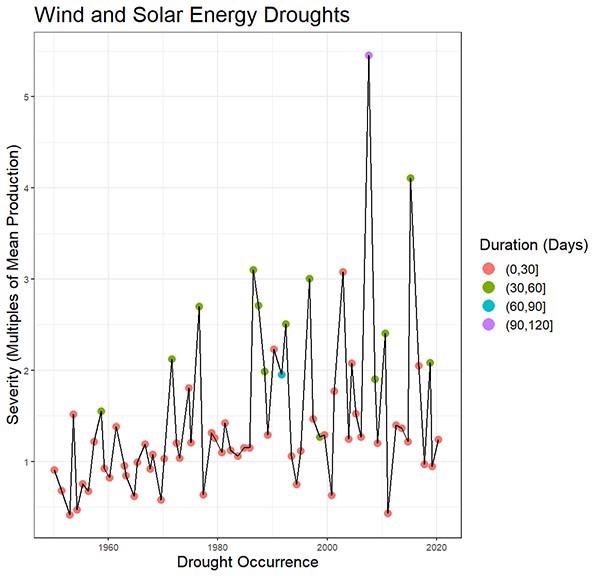Reviewed by Alex SmithApr 13 2022
Scientists, in a recent modeling study, demonstrated how extensively solar and wind potential differ by year and season, signifying that standby energy sources may be necessary as the world moves toward renewables to achieve zero carbon emissions.
 Columbia researchers built an AI model to estimate how long and severe an energy drought would be in a combined wind-solar system. (Image Credit: Upmanu Lall, Columbia Engineering).
Columbia researchers built an AI model to estimate how long and severe an energy drought would be in a combined wind-solar system. (Image Credit: Upmanu Lall, Columbia Engineering).
Prices of renewable energy have dropped by over 70% in the last 10 years, causing more Americans to ditch fossil fuels for greener, less-polluting sources of energy. But as solar and wind energy continues to advance, grid operators will possibly have to strategize for large fluctuates in availability.
The cautionary advice comes from Upmanu Lall, a professor at Columbia Engineering and the Columbia Climate School who has of late been shifting his sights from sustainable usage of water to sustainable renewables in the thrust toward net-zero carbon emissions.
Designers of renewable energy systems will need to pay attention to changing wind and solar patterns over weeks, months, and years, the way water managers do. You won’t be able to manage variability like this with batteries. You’ll need more capacity.
Upmanu Lall, Professor, Department of Earth and Environmental Engineering, Columbia University
The new modeling study has been published in the journal Patterns where Lall and Columbia Ph.D. student Yash Amonkar demonstrate that wind and solar potential differ extensively between days, weeks, months and years. They concentrated on Texas, which is the top country in producing electricity from wind power and is the fifth-largest producer of solar power.
Texas also has a self-contained grid that is as big as many countries, states Lall, making it a suitable laboratory for chronicling the promise and risk of renewable energy platforms.
Based on 7 decades of historic solar and wind power data, the scientists developed an AI model to estimate the chance of a network-scale "drought," when day-to-day production of renewables dropped under a target threshold.
Under a threshold fixed at the 30th percentile, when approximately a third of all days are minimum-production days, the scientists discovered that Texas could endure a daily energy drought for nearly 4 months straight.
Batteries would be powerless to make up for a drought of this length, said Lall, and if the system depended on just solar power, the drought could be estimated to last two times as long — for 8 months.
“These findings suggest that energy planners will have to consider alternate ways of storing or generating electricity, or dramatically increasing the capacity of their renewable systems,” he said.
Anticipating Future ‘Energy’ Droughts in Texas, and Across the Continental United States
The study commenced 6 years ago when Lall and David Farnham (a former graduate student), analyzed solar and wind variability at eight U.S. airports, where weather records were mostly longer and more comprehensive. They were keen to see how much difference could be anticipated under a theoretical 100% renewable energy grid.
The outcomes, which Farnham reported in his Ph.D. thesis, were not a shock. Farnham and Lall found that wind and solar potential, similar to rainfall, is very inconsistent based on the time of year and the place where solar panels and wind turbines have been positioned. Spanning eight cities, they discovered that renewable energy potential increased and decreased from the long-term average by nearly a third in certain seasons.
We coined the term ‘energy’ droughts since a 10-year cycle with this much variation from the long-term average would be seen as a major drought. That was the beginning of the energy drought work.
Upmanu Lall, Professor, Department of Earth and Environmental Engineering, Columbia University
In the present study, Lall decided to focus his study on Texas, a state blessed with both wind and sun. Amonkar and Lall discovered that incessant renewable energy droughts could endure for up to a year even if wind and solar generators were distributed across the whole state. The conclusion, Lall expressed, is that renewables will run into a storage issue that can only truly be solved by incorporating extra capacity or energy sources.
In a fully renewable world, we would need to develop nuclear fuel or hydrogen fuel, or carbon recycling, or add much more capacity for generating renewables, if we want to avoid burning fossil fuels.
Upmanu Lall, Professor, Department of Earth and Environmental Engineering, Columbia University
In seasons of low rainfall, water management operators sustain freshwater flow via the spigot by utilizing underground aquifers or municipal reservoirs. Wind and solar energy systems have no comparable backup. The batteries used to capture additional wind and solar power on remarkably gusty and bright days hold a charge for just a few hours, and a maximum of a few days.
Hydropower units offer a potential buffer, explains Lall, but not for sufficiently long to carry the system through a prolonged dry spell of sporadic wind and sun.
We won’t solve the problem by building a larger network. Electric grid operators have a target of 99.99% reliability while water managers strive for 90 percent reliability. You can see what a challenging game this will be for the energy industry, and just how valuable seasonal and longer forecasts could be.
Upmanu Lall, Professor, Department of Earth and Environmental Engineering, Columbia University
In the subsequent phase of the study, Lall will partner with Columbia Engineering professors Vijay Modi and Bolun Xu to see if they can estimate both energy droughts and "floods," when the system produces an excess of renewables. Equipped with these forecasts, they hope to estimate the increase and decrease of energy prices.
Journal Reference:
Amonkar, Y., et al. (2022) A k-nearest neighbor space-time simulator with applications to large-scale wind and solar power modeling. Patterns. doi.org/10.1016/j.patter.2022.100454.